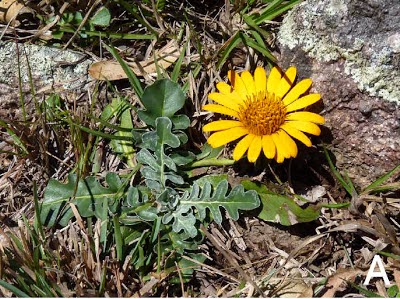Living in limestone habitats requires special adaptations from
plants; as such areas tend to have thin layers of alkaline soil over porous
bedrock, leading to frequent periods of aridity. Since exposed limestones are
most frequently found in upland areas surrounded by areas of lowlands with
different environmental conditions, the plants found in them are often highly
endemic (have very localized distributions).
In a paper published in the journal PLoS One on 8 October 2014, KohNakamura of the Biodiversity Research Center at Academia Sinica, Shih-Wen Chung
of the Botanical Garden Division of the Taiwan Forestry Research Institute, Yoshiko
Kono and Meng-Jung Ho, also of the Biodiversity Research Center at Academia
Sinica, Tian-Chuan Hsu, also of the Botanical Garden Division of the Taiwan
Forestry Research Institute and Ching-I Peng, again of the Biodiversity
Research Center at Academia Sinica, describe a new species of Chicory from the Taroko National Park in northeast Taiwan.
The new species is placed in the genus Ixeridium, and given the specific name calcicola. It is dwarfed compared to closely related species (a
common adaptation to limestone environments), reaching only 10-30 cm tall, with
oblong or lance-shaped leaves and yellow flowers.
Ixeridium calcicola in the wild. Nakamura et al.
(2014).
Most members of the genus Ixeridiumhave
seven pairs of chromosomes, whereas Ixeridium calcicola
was found to have eight, causing Nakamura et
al. to consider placing it in the related genus Ixeris, where eight chromosomes is more usual. However a full
genetic analysis suggested strongly that the new species belonged within Ixeridium rather than Ixeris, the additional chromosome being
due to the splitting of one of the longer chromosomes. This is also likely to
have led to the species becoming reproductively isolated, as it is very
difficult for plants to hybridize with even closely related species if they
have different numbers of chromosomes.
Ixeridium calcicola was found growing only on moist rocky ridges and limestone cliffs
at altitudes of 1150-2250 m. A total of five populations were discovered, three
of them within the Taroko National Park. Since even the sites within the park
are vulnerable to human disturbance, and the areas where the plant grows are
naturally prone to landslides, particularly after Earthquakes of periods of
heavy rainfall, Nakamura et al. suggest
that the plant should be considered vulnerable under the terms of the
International Union for the Conservation of Nature’s Red List of ThreatenedSpecies.
See also…
Hydrangeas are perennial woody plants related to Dogwoods and
Silkleafs. Most species form small shrubs, but some grow to tree sizes,
and there are some lianas (woody vines) in the group. Hydrangeas
are most abundant and diverse in eastern Asia, but they are found as
far west as the Himalayas, and also throughout the Americas. Most Hydrangeas have white flowers, but some species produce pink or blue flowers in
response to...
Hawkweeds (Hieracium spp.) are herbaceous flowering plants in the
Aster Family (Asteraceae), closely related to Dandelions. There are
numerous species in Europe, Africa, Asia, and North and South America,
though the precise number of species is open to dispute, as most
Hawkweeds are triploid (have three sets of chromosomes, which means that
they cannot reproduce sexually (which requires an even number of
chromosomes sets, which can then...
 New species of Daisy from Brazil. Daisies of the genus Trichocline are found across southern South
America, with a single species from Australia. They are small perennial
herbs with red, yellow, orange, or rarely white flowers found
on sandy or rocky grasslands, shrublands, or human-modified areas such
as roadsides with exposed soil, mostly at high...
New species of Daisy from Brazil. Daisies of the genus Trichocline are found across southern South
America, with a single species from Australia. They are small perennial
herbs with red, yellow, orange, or rarely white flowers found
on sandy or rocky grasslands, shrublands, or human-modified areas such
as roadsides with exposed soil, mostly at high...
Follow Sciency Thoughts on Facebook. New species of Daisy from Brazil. Daisies of the genus Trichocline are found across southern South
America, with a single species from Australia. They are small perennial
herbs with red, yellow, orange, or rarely white flowers found
on sandy or rocky grasslands, shrublands, or human-modified areas such
as roadsides with exposed soil, mostly at high...
New species of Daisy from Brazil. Daisies of the genus Trichocline are found across southern South
America, with a single species from Australia. They are small perennial
herbs with red, yellow, orange, or rarely white flowers found
on sandy or rocky grasslands, shrublands, or human-modified areas such
as roadsides with exposed soil, mostly at high...


